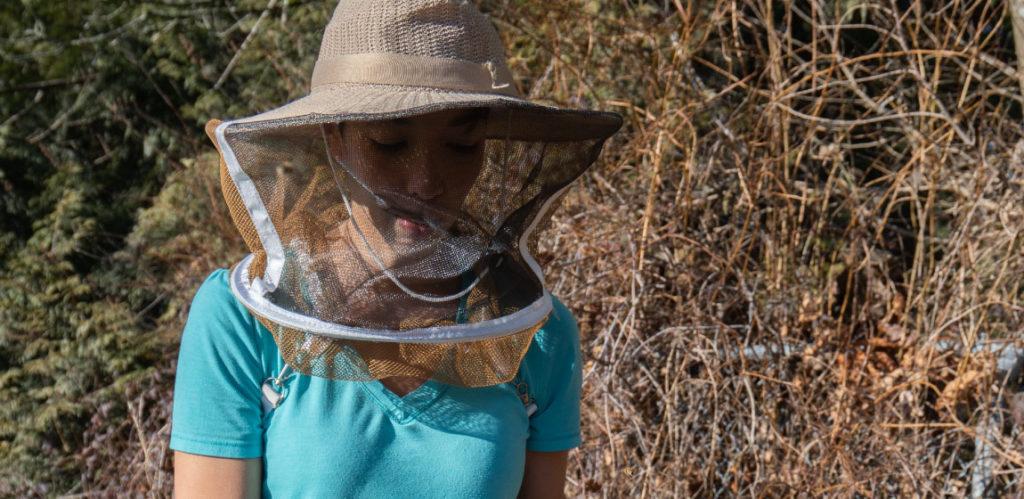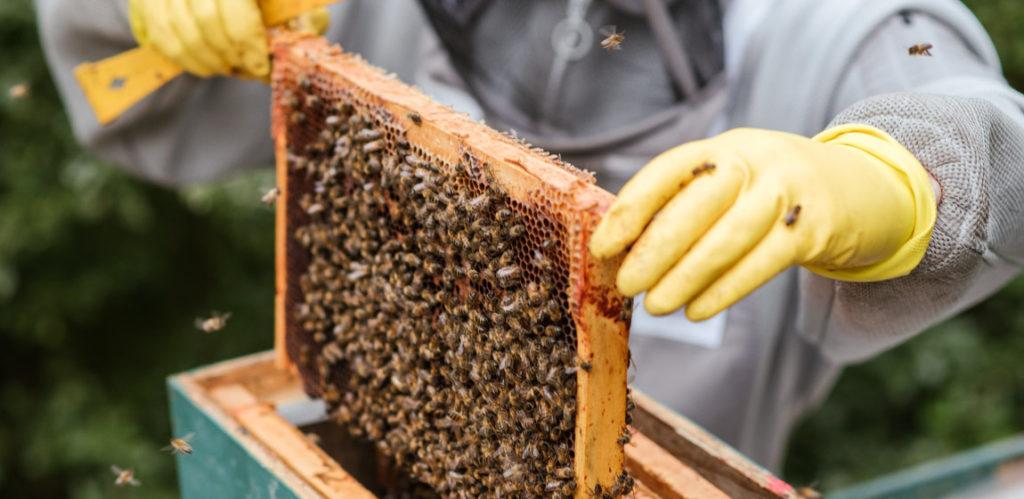BC heat waves threaten survival of bee colonies
By Silvia Moreno-Garcia

Insulated hives could protect bees from heat stress
It was a macabre sight. Dozens of dead drone bees spread over the ground, looking as if they had literally exploded from the inside out.
“When drones die from shock, they spontaneously ejaculate,” explains Dr. Alison McAfee, a postdoctoral fellow at UBC’s Michael Smith Laboratories who has long studied bee health. “They have this elaborate endophallus that comes out and is about the size of their own abdomen. It’s pretty extreme.”
McAfee maintains contact with a network of honey producers and beekeepers across British Columbia, including Emily Huxter, a beekeeper in Armstrong. In the midst of the province’s 2021 summer heat wave, Huxter began noticing dozens of dead drones on the ground. She took photos and e-mailed them to McAfee.
McAfee got in touch with other beekeepers around BC who were witnessing the same mass die-off of drones, prompting real concerns about the survival of colonies.
A few years before, in the research lab of UBC biochemist Prof. Leonard Foster, who works in the Michael Smith Laboratories, McAfee had discovered protein markers in bees that show how they cope with changes in their environment, for example, exposure to cold, heat or pesticides. The proteins serve as fingerprints, allowing us to understand how colonies react to different events.
McAfee’s focus had long been queen bees, which can serve as bio-monitors, allowing researchers to understand subtle changes in the environment. But as she reviewed the pictures from Huxter, she realized heat stress in drones could be a big issue, too.
Although bee researchers have studied heat stress and bee health, the inside of a colony is thermoregulated. It’s a stable environment that maintains a temperature of around 35 degrees Celsius. Huxter’s bees should have been able to cope with warm weather, but the heat wave pushed them to the brink.
“We know that after six hours at 42 degrees, half of drones will die of heat stress. The more sensitive ones start to perish at two, or three hours. That’s a temperature they shouldn’t normally experience, but we were seeing drones getting stressed to the point of death,” McAfee says.
A large portion of our diet is dependent on honey bee pollination. The estimated economic contribution of honey bees is around $4 to $5.5 billion a year in Canada — mainly due to pollination services for crops such as canola, apples, blueberries, cranberries and soybeans. In 2017, there were 10,544 beekeepers in Canada managing 789,598 colonies. Collectively they produced 92 million pounds of honey, with a value of $188 million.


Beekeepers don’t only sell honey, they also rear and sell queens. But queens need drones to mate with and McAfee was looking at photos of a drone apocalypse.
Bee colonies produce drones in preparation for ‘swarming’, the process by which a single colony splits into two if enough resources are available to sustain a new hive. Half of the bees follow their old queen, while the other half stay behind and rear a new one.
Beginning in May, drones will be born and eventually mate with the young queens. Queens mate with multiple males, between 10 and 20 drones. If they have inadequate mates their colonies will have less genetic diversity, which would make them less resistant to disease and other stressors.
Huxter’s queens normally have a mating success rate of around 75 to 80 per cent. But after the heat wave, only 40 percent of her queens successfully mated.
“Queens sell for $45 or more. Each queen that wasn’t able to mate is lost income, and there are only so many queens you can produce in a year,” McAfee explains.
After the first severe heat wave, McAfee and Huxter designed experiments to test hive insulation materials, attempting to protect the hives and drones from a predicted second, smaller heat wave.
“The other major problem that some beekeepers saw was that half of their ‘nucs,’ which are small starter colonies, died off during the first heat wave,” McAfee says. “That’s a massive die off and tells me we need to find better ways of protecting bees.”
Huxter installed temperature loggers to measure temperature changes inside a colony every 10 minutes and outfitted 18 colonies with two different types of insulation.
Six colonies were provided with a two-inch thick piece of Styrofoam at the top of the beehive. The top of the hive gets most of the radiant heat from the sun. The Styrofoam is a simple shield, making thermoregulating easier.
Huxter came up with another method of stabilizing temperatures — a feeder full of sugar syrup which would act as a bee cooling station.
“Bees will naturally go find water to bring back to the hive and fan it with their wings to cool down, which achieves evaporative cooling much like we do when we sweat. Giving them syrup nearby should let them do the same thing, and the sugar in it motivates them to take it down faster.”
McAfee and Huxter looked at 18 colonies — six serving as controls, six with Styrofoam insulation, and six fed with light syrup. Hives with Styrofoam lids were about 3.75 °C cooler than controls. Hives fed syrup were 1.1 °C cooler. The Styrofoam acted as a stabilizer — nighttime lows and daytime highs were both less extreme. McAfee believes beekeepers should consider using Styrofoam lids all the time since they protect bees from the heat in the summer, as well as the cold in the winter.
The research on cooling down drones is just beginning. She will continue analyzing the results of her insulation experiments and determining what could be done to help colonies at risk.
Although pictures of dead drones on the ground aren’t pretty, one of the positive outcomes of the massive heat wave of 2021 is that it drew McAfee’s attention to drones in the first place. She now believes drones may be even better indicators of environmental changes than queen bees.
“Drones have the advantage that they are very sensitive and easy to see. If drones are dying, it’s much easier to study them than to take a queen from a colony to perform tests. It’s also more conducive to citizen science efforts.”
Silvia Moreno-Garcia is a writer for UBC Science. This article was published on February 22, 2022. Feel free to republish the text of this article, but please follow our guidelines for attribution and seek any necessary permissions before doing so. Please note that images are not included in this blanket licence.


